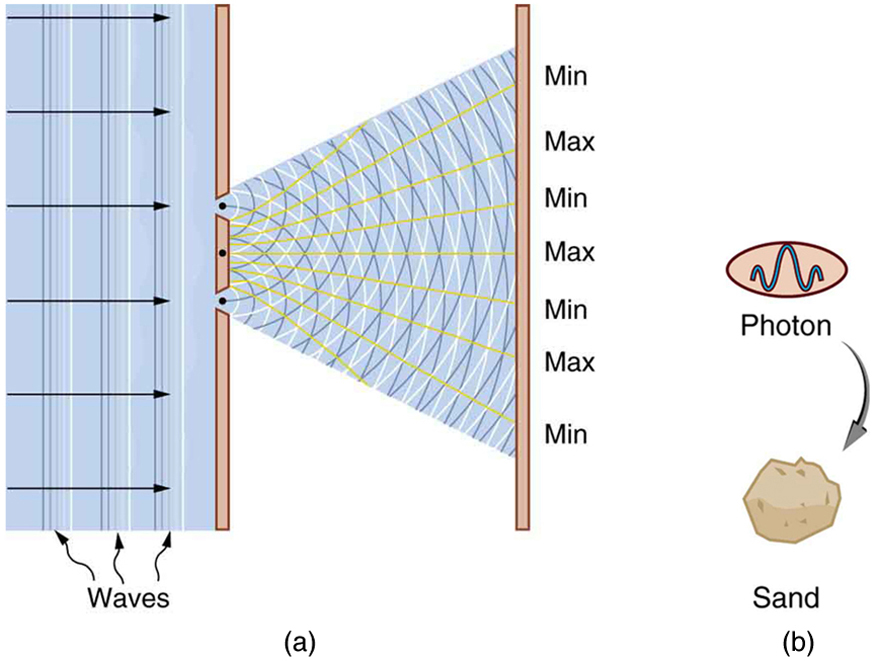

(Each ray is perpendicular to the wavefront of a wavelet.) Assuming the screen is very far away compared with the size of the slit, rays heading toward a common destination are nearly parallel. These are like rays that start out in phase and head in all directions. According to Huygens’s principle, every part of the wavefront in the slit emits wavelets. Here we consider light coming from different parts of the same slit. The analysis of single slit diffraction is illustrated in Figure 2. (b) The drawing shows the bright central maximum and dimmer and thinner maxima on either side. The central maximum is six times higher than shown. Monochromatic light passing through a single slit has a central maximum and many smaller and dimmer maxima on either side. In contrast, a diffraction grating produces evenly spaced lines that dim slowly on either side of center. Note that the central maximum is larger than those on either side, and that the intensity decreases rapidly on either side. Figure 1 shows a single slit diffraction pattern. Light passing through a single slit forms a diffraction pattern somewhat different from those formed by double slits or diffraction gratings. Discuss the single slit diffraction pattern.Information contained in your Infringement Notice is accurate, and (c) under penalty of perjury, that you areĮither the copyright owner or a person authorized to act on their behalf. Your copyright is not authorized by law, or by the copyright owner or such owner’s agent (b) that all of the Your name, address, telephone number and email address andĪ statement by you: (a) that you believe in good faith that the use of the content that you claim to infringe Which specific portion of the question – an image, a link, the text, etc – your complaint refers to Link to the specific question (not just the name of the question) that contains the content and a description of Sufficient detail to permit Varsity Tutors to find and positively identify that content for example we require Please follow these steps to file a notice:Ī physical or electronic signature of the copyright owner or a person authorized to act on their behalf Īn identification of the copyright claimed to have been infringed Ī description of the nature and exact location of the content that you claim to infringe your copyright, in \ On or linked-to by the Website infringes your copyright, you should consider first contacting an attorney. Thus, if you are not sure content located

Misrepresent that a product or activity is infringing your copyrights. Please be advised that you will be liable for damages (including costs and attorneys’ fees) if you materially Your Infringement Notice may be forwarded to the party that made the content available or to third parties such Means of the most recent email address, if any, provided by such party to Varsity Tutors. Infringement Notice, it will make a good faith attempt to contact the party that made such content available by If Varsity Tutors takes action in response to Information described below to the designated agent listed below. Or more of your copyrights, please notify us by providing a written notice (“Infringement Notice”) containing If you believe that content available by means of the Website (as defined in our Terms of Service) infringes one Next all we have to do is plug in the values that we know, and we can solve for the wavelength: Now that we have the equation, we can isolate the wavelength term: In this case, is equal to one because we're considering the first dark fringe (on the top/bottom of the central fringe). In the above equation, represents the wavelength of light, represents the length of the slit, and represents the location of the dark fringes (it can equal ). We're then asked to determine the wavelength of the light based on this information.įirst and foremost, we'll need to use the light diffraction equation: In this question, we're told that the size of the slit is, and the first of these dark fringes occurs at an angle of away from the slit. In such a case, there will be a central bright fringe, with alternating dark and bright fringes as one moves above and below the central fringe. In doing so, the light is diffracted, meaning that it is spread out along a viewing screen. For this question, we're presented with a scenario in which light is passing through a small slit.


 0 kommentar(er)
0 kommentar(er)
